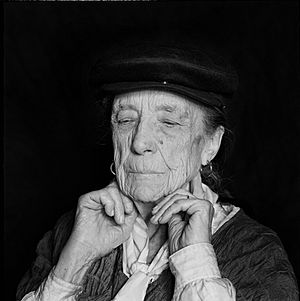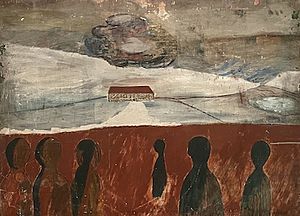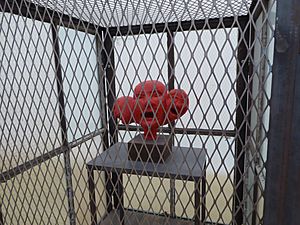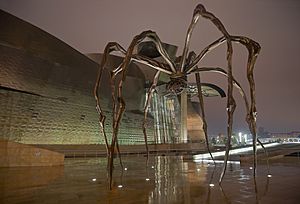Louise Bourgeois facts for kids
Quick facts for kids
Louise Bourgeois
|
|
|---|---|

Louise Bourgeois photographed by Oliver Mark, New York 1996
|
|
| Born |
Louise Joséphine Bourgeois
25 December 1911 Paris, France
|
| Died | 31 May 2010 (aged 98) New York City, U.S.
|
| Nationality | French |
| Education |
|
| Known for | |
|
Notable work
|
Spider, Cells, Maman, Cumul I, The Destruction of the Father |
| Movement |
|
| Awards | Praemium Imperiale |
Louise Joséphine Bourgeois (born December 25, 1911 – died May 31, 2010) was a famous French-American artist. She was best known for her large sculptures and installation art. But Louise Bourgeois was also a talented painter and printmaker.
Throughout her long career, she explored many ideas. These included themes about home life, family, death, and the unconscious mind. These ideas were often connected to events from her own childhood. She felt that making art was a way to deal with her feelings and experiences. Even though her work shared ideas with Surrealism and Feminist art, she didn't officially belong to any specific art group.
Contents
Life Story of Louise Bourgeois
Early Years and Education
Louise Bourgeois was born in Paris, France, on December 25, 1911. She was the middle child of three. Her parents, Joséphine Fauriaux and Louis Bourgeois, owned a gallery. They mainly sold old tapestries.
A few years after she was born, her family moved. They set up a workshop in Choisy-le-Roi to fix tapestries. Louise helped by drawing in the missing parts of the designs. The bottom parts of the tapestries were often damaged. This was usually from the feet of people and animals in the designs.
In 1930, Louise started studying math and geometry at the Sorbonne. She liked these subjects because they felt stable and orderly. She once said, "I got peace of mind, only through the study of rules nobody could change."
Her mother passed away in 1932. This sad event made Louise change her path. She decided to stop studying math and start studying art. She took art classes where she could help as a translator for English-speaking students. This way, she didn't have to pay for tuition. In one class, the artist Fernand Léger saw her work. He told her she was a sculptor, not a painter. Louise also worked as a guide at the Musée du Louvre.
Louise graduated from the Sorbonne in 1935. She continued her art studies in Paris. She attended famous schools like the École des Beaux-Arts and École du Louvre. She also studied at independent art academies. She wanted to learn as much as possible. She often visited artists' studios to learn their techniques.
In 1938, Louise opened her own art gallery. It was right next to her father's tapestry gallery. She showed art by famous artists like Henri Matisse. There, she met Robert Goldwater, an American art professor. They got married and moved to the United States. Robert taught at New York University. They had three sons, one of whom was adopted. Their marriage lasted until Robert's death in 1973.
Louise settled in New York City with her husband in 1938. She kept studying art at the Art Students League of New York. She focused on painting, sculpture, and printmaking. She once said about her early paintings, "The first painting had a grid: the grid is a very peaceful thing because nothing can go wrong... everything is complete."
Middle Years as an Artist

The early 1940s were a challenging time for Louise. She was adjusting to a new country. She also struggled to get her art shown in New York City. During this time, she made sculptures from old scraps and driftwood. She would paint the wood and add nails to create textures. One example is Sleeping Figure. This piece shows a war figure who feels too weak to face the world.
Throughout her life, Louise Bourgeois's art came from her own difficult past. She found comfort and inspiration by revisiting her childhood memories. She slowly gained more confidence in her art. However, she didn't get much attention from the art world during her middle years. She had her first solo show in 1945. In 1951, her father died, and she became an American citizen.
In 1954, Louise joined the American Abstract Artists Group. She became friends with artists like Willem de Kooning and Jackson Pollock. As part of this group, she started using new materials. She moved from wood to marble, plaster, and bronze. She explored feelings like fear, weakness, and losing control. This was a big change in her art. She said her art was like a journey. It started with the fear of falling, then became the art of falling, and finally, the art of "hanging in there." Her real-life struggles helped her create unique art. In 1958, Louise and her husband moved to a house in Chelsea, Manhattan. She lived and worked there for the rest of her life.
Louise Bourgeois often explored themes of being a woman in her art. Even though she didn't call her art "feminist," her works like Femme Maison (1946–1947) and Arch of Hysteria (1993) showed the female body. In 1976, Femme Maison was featured on the cover of a book about feminist art. It became a symbol for the feminist art movement.
Later Life and Recognition
In the 1970s, Louise Bourgeois started teaching art. She taught at places like the Pratt Institute and Cooper Union. She also taught printmaking and sculpture at the School of Visual Arts. For many years, she taught in public schools on Long Island.
In the early 1970s, Louise held special gatherings at her home. She called them "Sunday, bloody Sundays." Young artists and students would come, and Louise would give them feedback on their work. She was known for being very direct and having a dry sense of humor. Louise inspired many young artists to create art that explored feminist ideas. However, her assistant, Jerry Gorovoy, said that Louise thought of her own work as "pre-gender."
Louise also became involved in activism. She joined the Fight Censorship Group. This was a group of feminist artists who fought against censorship.
In 1978, Louise was asked to create her first public sculpture. It was called Facets of the Sun. The artwork was placed outside a federal building in Manchester, New Hampshire.
Louise Bourgeois had her first major art show in 1982. It was at the Museum of Modern Art in New York City. Before this, she was not widely known. In an interview, she shared that her sculptures were all about her own life. She explained that she used her art to deal with a difficult childhood experience. This involved a family situation with her father and governess.
In 1989, Louise had another big art show in Germany. In 1993, a major art survey in London did not include her work. This survey was criticized for leaving out many important artists, especially women. However, her works were chosen to be shown at the opening of the Tate Modern in London in 2000. In 2001, her art was shown at the Hermitage Museum.
In 2010, the last year of her life, Louise used her art to support LGBT equality. She created a piece called I Do. It showed two flowers growing from one stem. This artwork helped the organization Freedom to Marry. Louise said, "Everyone should have the right to marry. To make a commitment to love someone forever is a beautiful thing." She had supported LGBT equality before. In 1993, she made art for the AIDS activist group ACT UP.
Death
Louise Bourgeois passed away from heart failure on May 31, 2010. She was at the Beth Israel Medical Center in Manhattan. Wendy Williams, who managed Louise Bourgeois's studio, announced her death. Louise continued to create art right up until her final week.
The New York Times said that her art "shared a set of repeated themes." These themes focused on the human body and its need for comfort and safety in a scary world.
Her husband, Robert Goldwater, died in 1973. She was survived by two sons, Alain Bourgeois and Jean-Louis Bourgeois. Her first son, Michel, died in 1990.
Artworks by Louise Bourgeois
Femme Maison
Femme Maison (1946–47) is a series of paintings. In these works, Louise Bourgeois explored the connection between women and their homes. The paintings show women with houses instead of heads. This suggests their minds are focused on home life. It also shows how women might feel cut off from the outside world.
Destruction of the Father
Destruction of the Father (1974) is a powerful artwork. It explores how a father's power can affect his children. The piece is a soft, flesh-toned installation. It looks like a cozy, womb-like room. It is made from plaster, latex, wood, fabric, and red light. This was the first time Louise used soft materials on such a large scale.
When you enter the artwork, it feels like you are seeing the aftermath of a crime. It is set up like a dining room. The abstract, blob-like children have rebelled and "killed" their overbearing father.
Art as a Way to Heal
In 1982, the Museum of Modern Art in New York City showed Louise Bourgeois's work. She was 70 years old and used many different materials. These included paper, metal, marble, and animal bones. Difficult experiences from her childhood led her to use art as a way to "exorcise" her feelings. She wanted to get rid of her inner turmoil through her work. She felt she could explore ideas about female identity, the body, and broken families. She did this long before the art world talked about these topics. This was Louise's way to find balance and calm her emotions. The New York Times said her work was "charged with tenderness and violence, acceptance and defiance."
Cells
When she was in her eighties, Louise Bourgeois created two series of enclosed artworks. She called them Cells. Many of them are small spaces where you can look inside. They contain arrangements of symbolic objects. Others are small rooms you can walk into. In her Cell pieces, Louise used older sculptures, found objects, and personal items. These items had strong emotional meaning for her.
The Cells show different psychological and emotional states. They mainly express feelings of fear and pain. Louise said that the Cells represent "different types of pain; physical, emotional and psychological... Each Cell deals with a fear. Fear is pain..."
Maman
In the late 1990s, Louise Bourgeois started using the spider as a main image in her art. Maman is a giant sculpture. It stands over nine meters (30 feet) tall. The original is made of steel and marble. Six bronze copies were later made. It was first shown at the Tate Modern in London in 2000. It has been displayed in many places around the world.
Maman means "Mommy" in French. This sculpture represents the strength of Louise's mother. It uses ideas of spinning, weaving, caring, and protecting. The spider often appears in her work. Because of this, Louise Bourgeois was sometimes called Spiderwoman.
Maisons fragiles / Empty Houses
Louise Bourgeois's Maisons fragiles / Empty Houses are sculptures made of tall metal structures. They support a simple tray. You need to see them in person to feel their effect. They don't seem threatening or protective. Instead, they can bring out feelings of anxiety. A psychologist found that anxious children often draw tall, narrow houses without a base. Louise had a difficult childhood. This might explain why she created these pieces.
Printmaking Art
Louise Bourgeois's printmaking was very active at two times in her career. First, in the 1930s and 1940s, when she first moved to New York from Paris. Then again, starting in the 1980s, when her art became widely known. Early on, she made prints at home or at a famous workshop called Atelier 17. After that, she stopped printmaking for a long time to focus on sculpture.
She didn't start making prints again until she was in her seventies. She set up her old press and added a new one. She also worked closely with printers who came to her house. She continued making many prints until she passed away. During her life, Louise Bourgeois created about 1,500 printed artworks.
In 1990, Louise decided to give all her printed works to The Museum of Modern Art. In 2013, the museum launched an online catalog of her prints. It is called "Louise Bourgeois: The Complete Prints & Books." This website shows her creative process. It also connects her prints to her other artworks that share similar ideas and images.
Main Themes in Her Art

One important theme in Louise Bourgeois's art is childhood trauma and hidden emotions. Her 2002 work Give or Take shows hidden feelings. It represents the difficult choice people face between giving and taking throughout their lives. This idea is shown by the shape of the sculpture and its heavy material.
Motherhood is another common theme in Louise's work. Her mother encouraged her to draw and involved her in the tapestry business. Louise thought her mother was smart and organized. The spider, which often appears in her art, represents her mother. The idea of a spider spinning and weaving its web directly relates to her parents' tapestry business. It also symbolizes her mother, who fixed things.
Louise Bourgeois explored the idea of being a woman. She challenged traditional views and made art about motherhood. She didn't show women just as muses or perfect ideals. She has been called the "reluctant hero of feminist art." Louise Bourgeois had a feminist approach to her art. Like artists Agnes Martin and Eva Hesse, her work came from her experiences as a woman.
Architecture and memory are also important parts of Louise's art. Her works often feel natural, biological, and related to reproduction. Louise described architecture as a way to show memory. Or, memory as a type of architecture. The memories in her art were sometimes imagined. For example, she explored the "death" or "exorcism" of her father. These imagined memories mixed with her real ones. These included living near a slaughterhouse and her father's affair. For Louise, her father represented harm, war, and betrayal. Her 1993 work Cell (Three White Marble Spheres) shows fear and being trapped. The mirrors inside create a changed and distorted reality.
The spiral shape in her work shows a dangerous search for balance. It represents constant change, disorder, and dizziness. It can mean both positive and negative things. It can be about the future and the past, breaking apart and returning, hope and emptiness, plans and memories.
Louise Bourgeois's art is filled with confessions, self-portraits, memories, and fantasies. She was a restless person who used her sculptures to find peace and order. These were things she felt were missing during her childhood.
Art Collaborations
Do Not Abandon Me
This artwork was a collaboration between Louise Bourgeois and British artist Tracey Emin. They worked on it for two years. The piece was shown in London in 2010, a few months after Louise's death. The artwork shows male and female figures. A tiny female figure seems to be honoring a giant male figure, like a god. Louise Bourgeois created the watercolors, and Tracey Emin drew on top of them. It took Emin two years to decide what she would add. But once she knew, she finished all the drawings in one day. She believed every single one turned out perfectly. I Lost You is about losing children and losing life. Louise Bourgeois had to bury her son. For her, abandonment was about losing both her mother and her son. Even though the two artists were very different in age and style, their collaboration worked out smoothly.
Selected Works and Exhibitions
Documentary Films
- 1987 – Bourgeois, Louise. Louise Bourgeois: ART/new york No. 27. Inner-Tube Video.
- 2008 – Bourgeois, Louise. Louise Bourgeois: The Spider, the Mistress, and the Tangerine. Zeitgeist Films.
Exhibitions Around the World
- 1947 – Persistent Antagonism at San Francisco Museum of Modern Art, San Francisco.
- 1949 – Untitled at Art Institute of Chicago, Chicago.
- 1967 – Untitled at National Academy of Design, New York City.
- 1972 – Number Seventy-Two at Storm King Art Center, Mountainville.
- 1982 – Louise Bourgeois, at The Museum of Modern Art, New York City.
- 1982 – Eyes, marble sculpture, at Metropolitan Museum of Art, New York City.
- 1984 – Nature Study: Eyes at Albright-Knox Art Gallery, Buffalo.
- 1987 – Louise Bourgeois: Sculpture 1947–1955 at Gallery Paule Anglim, San Francisco, California.
- 1992 – Sainte Sebastienne at Dallas Museum of Art, Dallas.
- 1993 – Loiuse Bourgeois: Recent Work at U.S. Pavilion, 45th Venice Biennale, Venice, Italy.
- 1993 – Helping Hands in permanent display at Chicago Women's Park & Gardens as of 2011, Chicago.
- 1994 – The Prints of Louise Bourgeois at The Museum of Modern Art, New York City.
- 1994 – The Nest at San Francisco Museum of Modern Art, San Francisco.
- 1994 – Louise Bourgeois: The Locus of Memory, Works 1982–1993 at the Brooklyn Museum, Brooklyn and The Corcoran Gallery of Art, Washington, D.C.
- 1995 – Louise Bourgeois: The Locus of Memory, Works 1982–1993 at Galerie Rudolfinum, Prague.
- 1997 – Maman at Kemper Museum of Contemporary Art, Kansas City.
- 1999 – Maman at Guggenheim Museum Bilbao, Bilbao.
- 1999 – Granite eyeball benches and 25' bronze water fountain, at Agnes R. Katz Plaza, Pittsburgh, PA. Sculptures are currently on permanent display.
- 2000 – Fallen Woman at Galleria d'arte moderna Palazzo Forti, Verona.
- 2007 – Maman at Tate Modern, London.
- 2008 – Louise Bourgeois at Centre Georges Pompidou, Paris, Exhibition date: 5 March 2008 – 2 June 2008.
- 2008 – Louise Bourgeois Full Career Retrospective at Solomon R. Guggenheim Museum, New York City.
- 2008 – Nature Study at Inverleith House, Edinburgh.
- 2008 – Louise Bourgeois for Capodimonte at National Museum of Capodimonte, Naples.
- 2009 – Louise Bourgeois: Moi, Eugénie Grandet, un processus d'identification at Maison de Balzac, Paris.
- 2010 – Louise Bourgeois: The Fabric Works, at Fondazione Vedova Venice. Travelling to Hauser & Wirth, London.
- 2010 – Louise Bourgeois: Mother and Child at Gallery Paule Anglim, San Francisco, California.
- 2011 – Louise Bourgeois: À L'Infini at Fondation Beyeler, Riehen, Exhibition date: 3 Sep 2011 – 8 Jan 2012.
- 2011 – Louise Bourgeois. The Return of the Repressed, at Fundación Proa, Buenos Aires.Travelling to Instituto Tomie Ohtake, São Paulo and Museu de Arte Moderna, Rio de Janeiro.
- 2011 – Louise Bourgeois (1911–2010) at the National Gallery of Canada, Ottawa, Ontario, Canada, Exhibition date: 21 Apr 2011 – 18 Mar 2012.
- 2012 – Louise Bourgeois: Conscious and Unconscious at the Qatar Museums Authority Gallery, Katara, Doha, Qatar, Exhibition date: 20 Jan 2012 – 1 Jun 2012.
- 2012 – Louise Bourgeois: The Return of The Repressed at Freud Museum, Exhibition date: 7 March 2012 – 27 May 2012.
- 2012 – Louise Bourgeois: Late Works at Heide Museum of Modern Art, Exhibition date: 24 November 2012 – 11 March 2013.
- 2013 – Louise Bourgeois 1911–2010 at Museum of Contemporary Canadian Art, Exhibition date: 22 June 2013 – 11 Aug 2013.
- 2014 – Louise Bourgeois: A Woman Without Secrets at Middlesbrough Institute of Modern Art, Exhibition date: 18 Jul 2014 – 12 Oct 2014.
- 2015 – ARTIST ROOMS: Louise Bourgeois: A Woman Without Secrets at Southampton City Art Gallery, Exhibition date: 16 Jan 2015 – 18 April 2015.
- 2015 – Louise Bourgeois. Structures of Existence: the Cells at Haus der Kunst, Munich, Germany, Exhibition date: 27 Feb 2015 – 2 Aug 2015.
- 2015 – Louise Bourgeois: I Have Been to Hell and Back at Moderna Museet, Stockholm, Sweden, Exhibition date: 14 Feb 2015 – 17 May 2015.
- 2016 – Louise Bourgeois: Structures of Existence: The Cells at Guggenheim Museum, Bilbao, Spain, Exhibition date: 18 March 2016 – 4 September 2016.
- 2016 – Louise Bourgeois: Turning Inwards at Hauser & Wirth, Switzerland, Exhibition date: 2 Oct 2016 – 1 Jan 2017
- 2017 – Louise Bourgeois: Human Nature: Doing, Undoing, Redoing at Kistefos-Museet, Jevnaker, Norway, Exhibition date: 21 May 2017 – 9 Oct 2017.
- 2017 – Louise Bourgeois: Spiders at San Francisco Museum of Modern Art, Exhibition date: 7 Oct 2017 – 4 Sept 2018.
- 2017 – Louise Bourgeois: Twosome at Tel Aviv Museum of Art, Tel Aviv, Israel, Exhibition date: 7 Sept 2017 – 17 Feb 2018.
- 2017 – Louise Bourgeois: An Unfolding Portrait at The Museum of Modern Art, Exhibition date: 24 Sept 2017 – 28 Jan 2018.
- 2018 – Louise Bourgeois: The Empty House at Schinkel Pavillon, Berlin, Exhibition date: 21 April 2018 – 29 July 2018.
- 2018 – Louise Bourgeois: To Unravel a Torment at Glenstone Museum, Potomac, MD, United States, Exhibition date: 10 May 2017 – 1 Jan 2020.
- 2019 – Louise Bourgeois & Alex Van Gelder at UM Museum, Seoul, South Korea, Exhibition date: 1 Oct 2019 – 31 Dec 2019.
- 2019 – 1999-12-03 Abels, Carolyn, "Katz Plaza in Cultural District is Dedicated," Pittsburgh Post-Gazette (v73, n125, B-1)
- 2021 – Louise Bourgeois, Freud's Daughter at The Jewish Museum, New York, NY, United States, Exhibition date: 21 May 2021 – 12 Sept 2021.
Awards and Honors
- 1972: Mary Beth Edelson's Some Living American Women Artists / Last Supper included Louise Bourgeois. This famous artwork showed women artists in a new way. It became a symbol of the feminist art movement.
- 1977: Received an honorary doctorate from Yale University.
- 1981: Became a Fellow of the American Academy of Arts and Sciences.
- 1990: Elected into the National Academy of Design.
- 1990: Awarded the Edward MacDowell Medal.
- 1991: Received the Lifetime Achievement in Contemporary Sculpture Award.
- 1997: Honored with the National Medal of Arts.
- 1999: Won the Praemium Imperiale for her lifetime achievements.
- 1999: Received the Golden Lion at the Venice Biennale.
- 2003: Awarded the Wolf Foundation Prize in the Arts.
- 2005: Received the Austrian Decoration for Science and Art.
- 2008: Awarded the National Order of the Legion of Honour.
- 2009: Honored by the National Women's Hall of Fame.
Where Her Art is Kept
Many important collections hold Louise Bourgeois's work.
- In the US: The National Gallery of Art in Washington, D.C., the Museum of Modern Art in New York, the Nasher Sculpture Center, and the San Francisco Museum of Modern Art.
- In Canada: The National Gallery of Canada.
- In the UK: The Tate Modern in London.
- In France: The Centre Pompidou in Paris.
Louise knew many of the people who collected her art. These included Ginny Williams, Agnes Gund, Ydessa Hendeles, and Ursula Hauser. Other private collections also have important pieces by Louise Bourgeois, like the Goetz Collection in Munich.
Art Market and Sales
Louise Bourgeois started working with art galleries in the late 1980s and 1990s. These included Gallery Paule Anglim, Karsten Greve, and Hauser & Wirth. Hauser & Wirth has been the main gallery for her art collection since her death. Other galleries, like Kukje Gallery in Seoul, also sell her work.
In 2011, one of Louise Bourgeois's sculptures, called Spider, sold for $10.7 million. This was a new record price for her art at an auction. It was also the highest price paid for a work by a woman artist at that time. In late 2015, the same sculpture sold again for $28.2 million.
Images for kids
-
Sculpture by Bourgeois in the Domestic Incidents group exhibit at London's Tate Modern Turbine Hall, 2006
See also
 In Spanish: Louise Bourgeois para niños
In Spanish: Louise Bourgeois para niños



